Bai Dinh Pagoda is a place for ecotourism with ties to the Dinh, Early Le, and Ly feudal states that go back more than a thousand years. Both the old and new Bai Dinh Pagodas are part of the complex, which is in Gia Sinh Commune, Ninh Binh Province, about 95 kilometres from Hanoi.
It covers 539 hectares of land. This is an important place to visit on your trip. It has the biggest Buddhist pagodas in Vietnam and holds many other records for the country, Southeast Asia, and Asia.
Join Vietnam Budget Car Rental on an adventure to the Bai Dinh Pagoda complex and discover why Buddhists from all over Vietnam come here.
History of the Bai Dinh Pagoda
During the Dinh, Early Le, and Ly dynasties, Buddhism was essential and seen as the national faith in Ninh Binh, the capital of Hoa Lu. During these dynasties, many pagodas were built in the area. On the western slope of Dinh Mountain, the old Bai Dinh Pagoda is one of them. The pagoda was built during the Dinh Dynasty, but its features and artefacts clearly show they were made during the Ly era.
The name of the pagoda, Bai Dinh, means "heading to Dinh Mountain." This is where significant events in Vietnamese history happened, like when King Dinh Tien Hoang built an altar to pray for good weather or when King Quang Trung held a flag ceremony to motivate soldiers before going to Thang Long to defeat the Qing army.
In the 1600s, the feudal family Le-Trinh and the Mac dynasty fought over Dinh Mountain. At the time, the Mac government only controlled the land from Ninh Binh backwards. During the resistance war, Bai Dinh was also a revolutionary relic in the Quynh Luu battle zone. This is where the leaders of the Communist Party of Vietnam told the people about the revolution.
The modern Bai Dinh Pagoda is part of a complex that includes the old and new pagoda that was finished in 2003.
You can now find the old Bai Dinh Pagoda about 800 meters south of Tam The Hall of the New Pagoda. A big prayer hall and natural rocks make up this peaceful temple. People pray to Buddha and mountain spirits like Genie Cao Son and Saint Nguyen there. In 1997, the old pagoda was named a national historical, cultural, and political relic.
The media have called the new building and the old tower the largest Southeast Asian complex. They are both grand, huge and very traditional. Even though it was still being built, this new spot quickly became a famous tourist spot that drew many people.
>>Read more: Things to Do in Hue, Vietnam: Thien Mu Pagoda
When is the best time to go to Bai Dinh Pagoda Complex?
January to March is the best time to visit Bai Dinh Pagoda because the weather is nice. You can travel to beautiful places, pray at pagodas, and attend critical regional events simultaneously. But this is also the busiest time of year for festival-goers, so it will be very crowded. If you want to avoid overcrowded people, you could also go to Bai Dinh Pagoda at different times of the year.
Architecture of the Bai Dinh Pagoda Complex
This religious complex's magnificent architecture and unique landscape will amaze tourists when they arrive.
To start your tour, you will go to the new Bai Dinh Pagoda on the 80-hectare Ba Rau hills near the Hoang Long River. This is a massive complex with many buildings built in stages from 2003 to 2010. 500 artisans from traditional villages all over the country finished them.
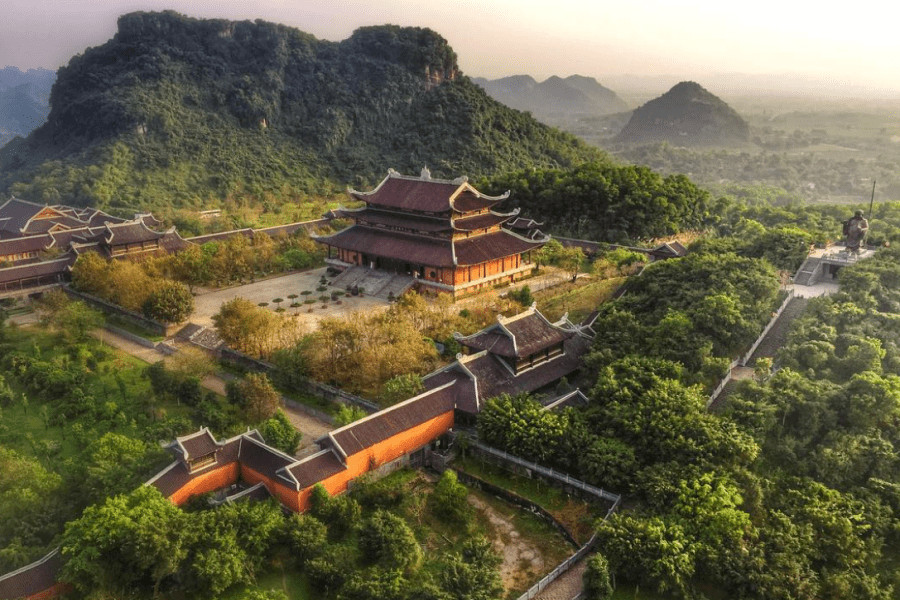
Top view Bai Dinh pagoda
The pagoda is mainly made of things in the area, like Ninh Binh green stone, quartet wood, dark brown Bat Trang painted tiles. The pagoda's design also reminds people of well-known Vietnamese artisan towns, like Y Yen, which makes bronze; Ninh Van, which carves stone; Phu Loc, which builds furniture; and Ninh Hai, which embroiders.
You can rent an electric car for a fee and start your trip at the reception area, where you will get some basic information. The main parts can be reached through the external or internal triple gates. From here, you can see the most critical parts of the new tower, such as:
Hallway with statues of Arhats
This building is made of wood and has a "Gia chieng-Chong ruong" truss style. It has two sides that are 3.40m long and 250 rooms that are 4.5m x 4.5m. 500 Arhat statues, carved from stone blocks by residents of the Ninh Van stone craft hamlet (Hoa Lu), line the right and left halls.

Statue of Arhats
Each statue, which is between 2 and 2.5 meters tall and between 2 and 2.5 tons heavy, has a unique posture and facial expression that can't be found on any other statue. This shows how Taoist theory applies to everyday life with feelings of happiness, anger, love, and hatred. People say that the hallway with the Arhat statues is Asia's most extended passage.
Bodhisattva Avalokitesvara Hall
The seven-part Bodhisattva Avalokitesvara Hall is 14.8 meters tall, 40.4 meters long, and 16.8 meters wide. The temple's main room has an 80-ton metal statue of Bodhisattva Avalokitesvara covered in gold. The statue has many eyes and hands. It is known as the biggest metal statue of the Bodhisattva Avalokitesvara in Vietnam.
Maitreya Statue

Maitreya Statue
There is a statue of Maitreya on the pagoda complex's most prominent hill, about 100 meters above sea level. It is made of metal, is 10 meters tall, weighs 80 tons, and shows Maitreya as a monk who is mumbling. The Southeast Asian metal statue of Maitreya is the biggest one that can be seen outside.
The Bell Tower
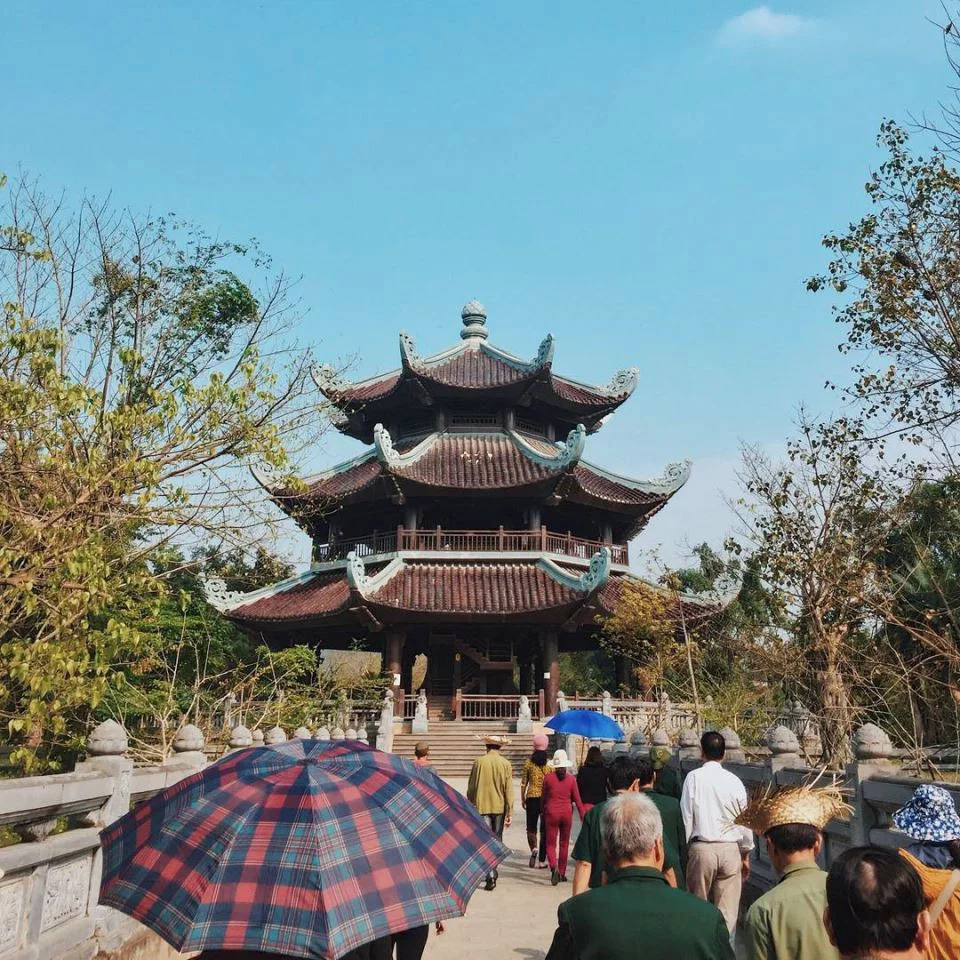
Bell Tower
It is 17 meters wide and 22 meters tall. It looks like a lotus flower. The tower is made of reinforced concrete and is shaped like an old bell tower. It has an octagonal shape and a three-layer curved roof with dark brown painted tiles made in Bat Trang pottery village.
Inside the Bell Tower is a 36-ton metal bell that skilled craftsmen in Hue made. This bell is the biggest in Vietnam.
Next to the bronze bell is a Dong Son Bronze drum. It's over 6 meters wide and 7 meters tall, weighing 13 tons.
>>Read more: The Huong Pagoda: A Must-See Attraction in Spring
Phap Chu Hall
There are 5 parts to Phap Chu Hall. The bronze Buddha statue in the middle compartment is 10 meters tall and weighs 100 tons, which is why it is called "Vietnam's largest bronze statue." Three panels and the three most enormous chairs in Vietnam can also be found in this hall.
Tam The Hall
It is 76 meters above sea level, 59.1 meters long, and 40 meters wide. The three metal statues of Tam The Buddha (past, present, and future) are the tallest and heaviest in Vietnam. They are 7.2 meters tall and weigh 50 tons each.
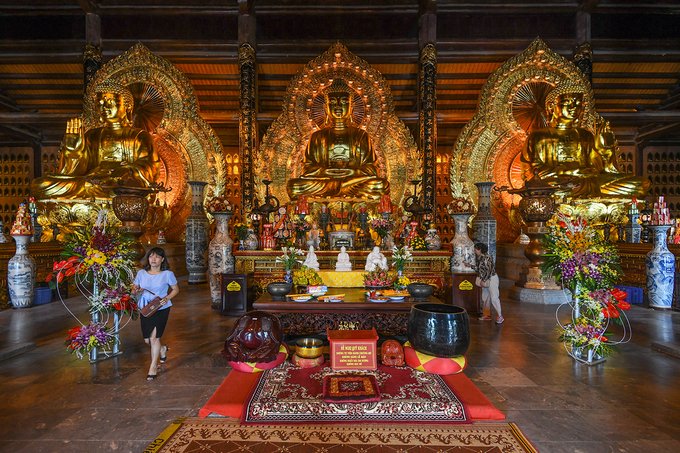
Tam The Buddha
Releasing Lake
This lake is 77 meters long and 63 meters wide. The lotus is a symbol of the Buddha and peace. The pagoda is Yang, and the lake is Yin. Together, they create a beautiful "waterfront, leaning against the mountain" scene that balances Yin and Yang.
Bao Thap Tower
Sacred Buddha relics from India and Burma are kept in the Bao Thap Tower, a building that is 100 meters tall and has 13 stories and 72 steps. In a mysterious Indian way, the ceiling of the tower is made.
The walls around the building are carved with Buddhist symbols. There are thousands of tiny figures all over the area. You can walk 72 steps to the top and see a view of the pagoda and the area around it, or you can pay extra to take an elevator.
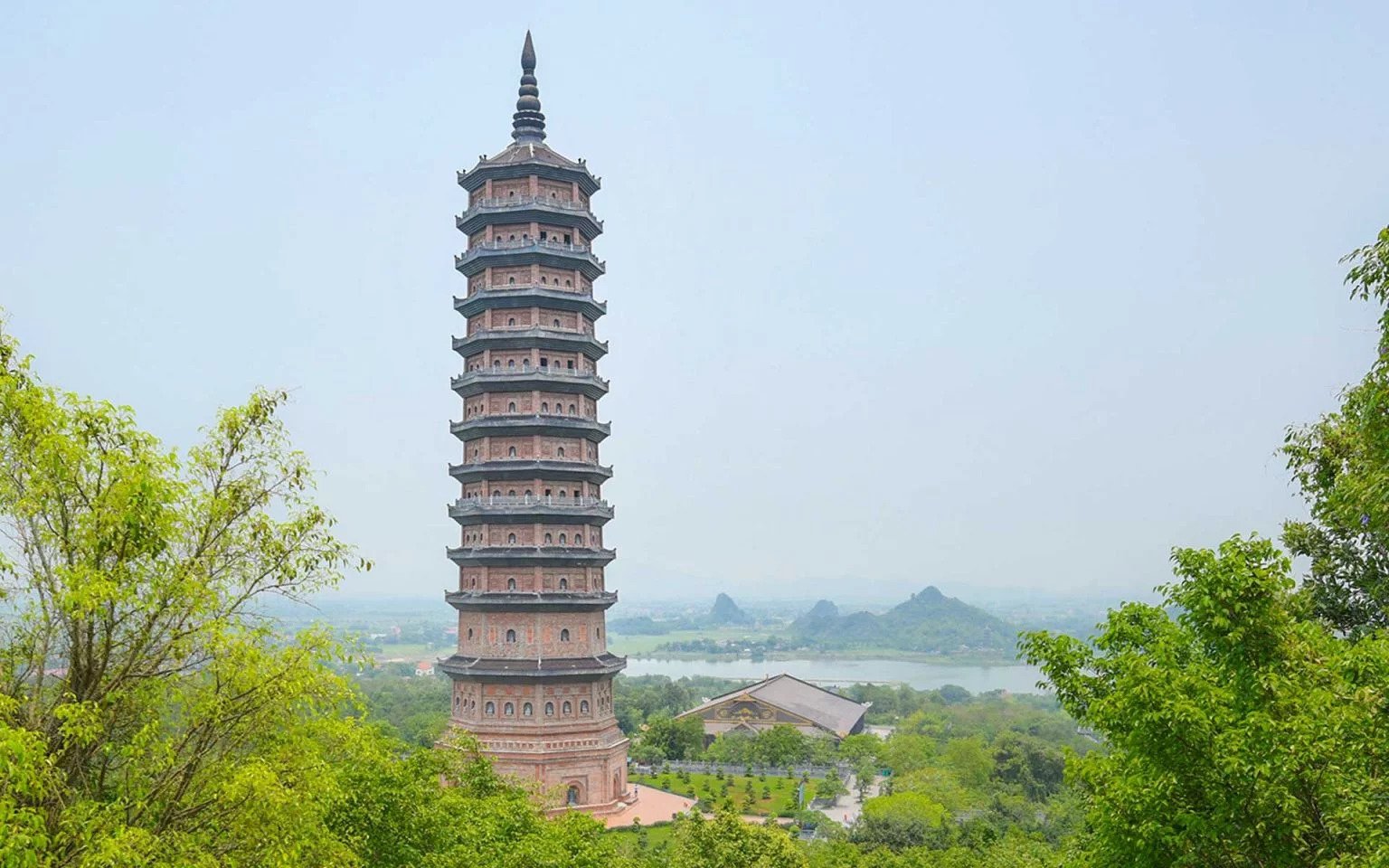
Bao Thap tower
You should also check out the new pagoda's more critical sites, like Stone House, which has 55 rooms with a stone that is 2.9 meters tall, 1.45 meters wide, and 0.40 meters thick sitting on top of a stone turtle that is 2.95 meters long, 1.70 meters wide, and 0.97 meters thick; or Bodhi Tree Garden, which is known for having the most Bodhi trees in Vietnam (100 trees brought in from India).
There are enough facilities at the new pagoda for anyone or any group who wants to stay overnight for a more in-depth experience or hold a conference. For example, the International Conference Center has up to 3500 seats and modern audiovisual equipment, where Vesak 2014 was held successfully.
The Bai Dinh Hotel is inside the pagoda, which offers many services such as lodging, conferences, and great vegetarian food at the Bon Mua restaurant.
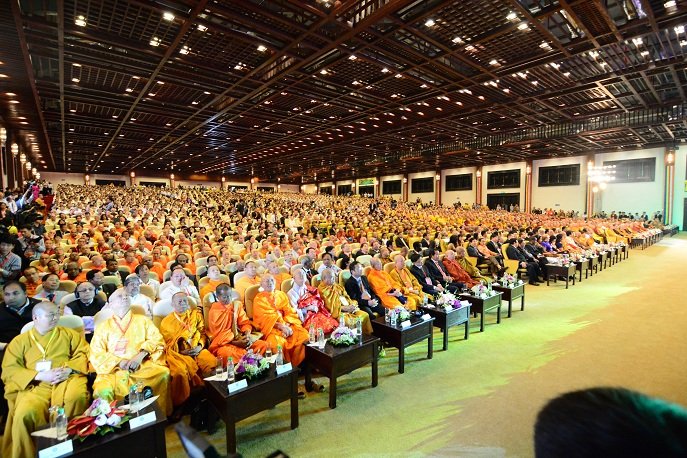
Inside Pagoda
The new fairy tale building is big and grand, but the old pagoda is much smaller and simpler. It is tucked away near the top of a mostly calm mountain range. About 800 meters south of Tam The Hall of the New Pagoda, it spreads over 27 hectares.
Near the base of Dinh Mountain is Ngoc Well, also known as Pearl Well. It will catch your attention first. As did Crown Prince Duong Hoan about a thousand years ago, Buddhist monk Nguyen Minh Khong used water from the well to make plant medicines for people in the area.
The well site is 6000m2 and is 30m wide and 6m deep. The well's water lever has never run dry since it was built, which is a surprise. The Vietnam Book of Records lists this well as the biggest Ngoc Well in the country.
>>Read more: Private Car Transfer From Ninh Binh To Hanoi Airport
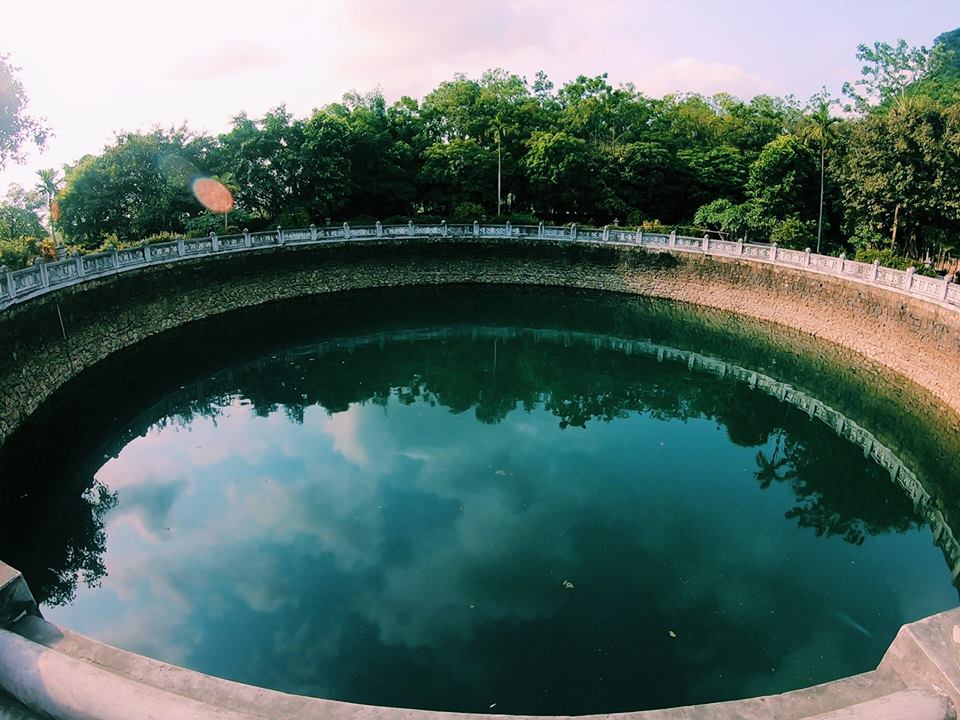
Pearl Well
A 300-step path goes up the mountain to the old Bai Dinh Pagoda. Overall, the old pagoda is shaped like "Tien Nhat - Hau Cong," with the front part written in "Nhat" script and the back part written in "Cong" script. This shape firmly sets classic harmonious architectural design with its vivid engravings of old architectural patterns, including fresh flowers, strong dragons, and unicorns.
There is a temple to Buddha in the Light Cave and a temple to the mountain god Genie Cao Son in the Cao Son temple.
People honored Saint Nguyen (Nguyen Minh Khong), a Zen Master and skilled magician, and Vu Lam guarded the entrance to the western Hoa Lu ancient city. The shrine of Saint Nguyen was also known as the Dark Cave, where people worshiped motherhood and fairies.
All Buddhist, Mother, and Fairy worship boards are set up in the dark heart of the caves, which adds to the spooky and solemn atmosphere. The top of the cave has been turned into the strong roof of the old pagoda, keeping it safe for generations. According to Vietnamese myth, this is where Kings, Saints, and Gods were born.
Ticket price to visit Bai Dinh Pagoda
Because the temple grounds are very large and connected to Trang An an eco tourism complex, one of the 10 best places to visit in Ninh Binh, you can combine additional tours and related services with the following costs:
- Electric car rental: 30,000 VND/way.
- Explore Trang An scenic spot: ferry ticket price is 150,000 VND/person.
- Tram ticket: 60,000 VND/person
- Tickets to visit the Stupa: 50,000 VND/person
- Tour guide ticket price: 300,000 VND/tour
The festival at Bai Dinh Pagoda
This spring event starts in the afternoon of the first day of Tet break and goes until the end of March. This is the start of the party for the pilgrimage to Hoa Lu, which used to be the capital of Ninh Binh Province.
The festival has two parts: the ceremony and the event itself. As part of the rituals, people burn incense to honor Buddha, remember Saint Nguyen's good deeds, worship Genie Cao Son, Saint Nguyen, and Thuong Ngan God Mother, and carry the procession of worshiping Genie Cao Son, Saint Nguyen, and Thuong Ngan God Mother from the old pagoda to the new pagoda to run the festival.
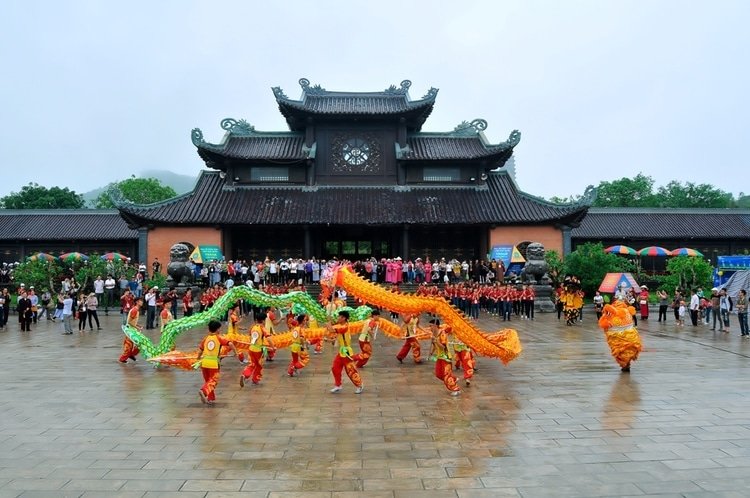
There are also folk games, caves and pagodas tours, and Cheo and Xam Dat singing. Ninh Binh Cheo Theater also held a reenactment ceremony for King Dinh Tien Hoang and a chess ceremony for King Quang Trung on Dinh Mountain before the fight.
These big celebrations draw many people because they occur in a huge pagoda complex. There are relics of the kings Dinh Tien Hoang, Quang Trung, and Le Thanh Tong at the Bai Dinh Pagoda Festival, and people worship Saint Nguyen, Genie Cao Son, and Thuong Ngan God Mother. The festival also includes worship of nature and beliefs from Buddhism, Motherism, and even Confucius.
>>Read more: Rent A Car With English Speaking Driver Halong Bay to Ninh Binh Hanoi
How are you going to get there?
The old city of Hoa Lu is about 12 kilometers away, Ninh Binh City is 25 kilometers away, and Hanoi is 95 kilometers away.
From the center of Ninh Binh, getting to the place by motorbike, scooter, taxi is easy.
If you take a taxi, car, or van, the trip to Bai Dinh Pagoda Complex will take about two hours. It might take more than two hours to ride a motorbike there.
There are also buses from Hanoi to Ninh Binh with some trusted suppliers such as Vietnam Budget Carental, Huu Binh Limousine, X.E Vietnam Limousine, Daily Limousine, Trang An Limousine… with the price range from 125,000VND – 400,000VND/ticket depending on each supplier with several time schedule per day.
By train Hanoi – Ninh Binh (~ US$ 10/ticket for soft seat):
Station in Hanoi: 120 Le Duan Street, Hoan Kiem District, Hanoi City
Station in Ninh Binh: 1 Hoang Hoa Tham Street, Thanh Binh District, Ninh Binh City.
| Train |
SE7 |
SE5 |
SE9 |
SE3 |
SE19 |
| Departure |
6:00 |
8:50 |
14:25 |
19:25 |
20:00 |
| Arrival |
8:14 |
11:04 |
16:05 |
21:39 |
22:09 |
* Train schedule is subject to change according to the weather condition or operation safety.
Then you continue to go Bai Dinh Pagoda by taxi or motorbike (~ 30 minutes more); or stay overnight at hotel if catching a late train and visit the pagoda the next day.
>>Read more: Top 5 Best Train Brands in Vietnam
The Bai Dinh Pagoda complex is a work of art. It is the Vietnamese people's pride in its unique architecture, culture, and history.
Ninh Binh City is open to people with a wide range of interests, from religious views to nature tours and exciting activities like hiking, biking, and kayaking.
You can spend one full day or more (2,3 days…) to have enough time for a combined visit with other attractions of the city such as Bai Dinh Pagoda – Trang An complex; Tam Coc – Bich Dong; Mua Cave; Van Long Nature Reserve Center; Thung Nham Bird Sanctuary; Tuyet Tinh Coc; Cuc Phuong National Park; Phat Diem Stone Cathedral…
Contact us Vietnam Budget Car Rental to get the best services we offer you.
Things you need to consider when traveling to Bai Dinh
Although Bai Dinh Pagoda is an attractive tourist destination, you also need to pay attention to the following issues to have the most complete travel trip:
- Because you will walk quite a lot during the journey to visit the temple, you should wear sports shoes instead of high heels to help you move more quickly.
- If you want souvenirs, wait until you get off the mountain to buy them. Because if you buy inside the temple grounds, the price will be exorbitant.
- Please bring a few coins to donate and pray for good luck for yourself and your family.
- If you go in early spring, you should bring an umbrella to prevent heavy drizzle.
